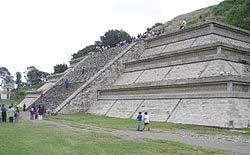
Mesoamerican pyramids, pyramid-shaped structures, are an important part of ancient Mesoamerican architecture. These structures were usually step pyramids with temples on top – more akin to the ziggurats of Mesopotamia than to the pyramids of Ancient Egypt. The Mesoamerican region's largest pyramid by volume – indeed, the largest in the world by volume – is the Great Pyramid of Cholula, in the Mexican state of Puebla.
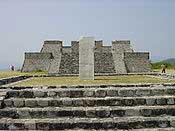
Aztecs
The Aztecs, a people with a rich mythology and cultural heritage, dominated central Mexico in the 14th, 15th and 16th centuries.[1] Their capital was Tenochtitlan on the shore of Lake Texcoco – the site of modern-day Mexico City. They were related to the preceding cultures in the basin of Mexico such as the culture of Teotihuacan whose building style they adopted and adapted.
Malinalco
Templo Mayor
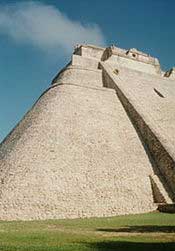
Maya
The Maya are a people of southern Mexico and northern Central America (Guatemala, Belize, western Honduras, and extreme northern El Salvador) with some 3,000 years of history. Archaeological evidence shows the Maya started to build ceremonial architecture approximately 3,000 years ago. The earliest monuments consisted of simple burial mounds, the precursors to the spectacular stepped pyramids from the Terminal Pre-classic period and beyond. These pyramids relied on intricate carved stone in order to create a stair-stepped design. Many of these structures featured a top platform upon which a smaller dedicatory building was constructed, associated with a particular Maya deity. Maya pyramid-like structures were also erected to serve as a place of interment for powerful rulers. Maya pyramidal structures occur in a great variety of forms and functions, bounded by regional and periodical differences. Altun Ha
Calakmul
Caracol
Comalcalco
Copan
Chichen Itza
El Mirador La Danta temple, is also the name of the largest Maya temple. The temple reaches 79 metres (259 ft) high, and with a volume of 2,800,000 cubic meters, it is one of the largest pyramids in the world. El Tigre
Los Monos
Lamanai
Palenque: Temple of the Inscriptions
Tikal: Tikal Temple I; Tikal Temple V
Tarascans
The Tarascan state was a precolumbian culture located in the modern day Mexican state of Michoacán. The region is currently inhabited by the modern descendents of the P'urhépecha. Tarascan architecture is noted for "T"-shaped step pyramids known as yácatas.
Tzintzuntzan
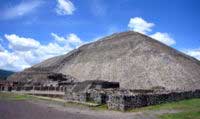
Teotihuacan
The Teotihuacan civilization, which flourished from around 300 BCE to 500 CE, at its greatest extent included most of Mesoamerica. Teotihuacano culture collapsed around 550 and was followed by several large city-states such as Xochicalco (whose inhabitants were probably of Matlatzinca ethnicity), Cholula (whose inhabitants were probably Oto-Manguean), and later the ceremonial site of Tula (which has traditionally been claimed to have been built by Toltecs but which now is thought to have been founded by the Huastec culture).
El Castillo &
High Priest's Temple in Chichen Itza
Pyramids of the Sun, the Moon and Temple of the Feathered Serpent in Teotihuacan
Xochicalco
Tula
Talud-tablero
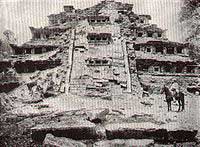
Classic Veracruz
The best known Classic Veracruz pyramid, the Pyramid of Niches in El Tajín, is smaller than those of their neighbours and successors but more intricate. El Tajín
Zapotecs
The Zapotecs were one of the earliest Mesoamerican cultures and held sway over the Valley of Oaxaca region from the early first millennium BCE to about the 14th century. Monte Albán Mitla